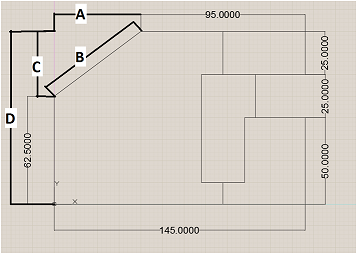Reference no: EM13989918
Part 1 - Short answer.
What are three ways to initiate a command (e.g. begin drawing a line)?
1)
2)
3)
When drawing a line from the Start point to the End point. Using different types of coordinates (e.g. Absolute coordinates, Relative coordinates, and/or Polar coordinates), provide TWO ways to define the End point. For extra credit, provide all three.

There are two different ways to change the font size of the text of the dimensions (Explain one)?
What is the purpose of setting your Drawing Limits prior to beginning a drawing?
Describes the steps to setting the Drawing Limits.
What is the benefit of having multiple layers in a drawing?
What is the minimum distance a dimension should be placed nearest to an object? What is the minimum distance a succeeding parallel dimension should be placed?
On the following drawing, identify any corner that has a "fillet" and any which has a "chamfer". Provide two brief descriptions of ways that the rounded corner could be made.

Part 2 - Dimensioning. Determine missing dimensions.
A
B
C
D

Part 3 - Matching- Select the best description (letters) to describe the term (numbers). Write the letter for the description in the space provided next to the term.
|
1) Absolute coordinates
|
A) Providing a dimension for the same characteristic more than once
|
|
2) Relative coordinates _
|
B) Examples include Architectural, Engineering, and Decimal
|
|
3) Polar coordinates
|
C) Location provided by distance and angle
|
|
4) Grid
|
D) Rounds the Edges of an object
|
|
5) Snap
|
E) Creates multiple parallel lines
|
|
6) Ortho Mode
|
F) Allows only horizontal or perpendicular lines to be drawn
|
|
7) Drawing Limits
|
G) Location provided by X & Y coordinates, relative to the origin
|
|
8) Units
|
H) Fills an enclosed area or selected objects with a solid, pattern or gradient fill
|
|
9) Grips
|
I) Located at the bottom of the screen, provides an additional input (and output) method
|
|
10) Command Line
|
J) Causes the cursor to move in specified increments
|
|
11) Chamfer
|
K) Include Linear, Aligned and Angular
|
|
12) Overdimensioning
|
L) Major component edge is not aligned to the major axes
|
|
13) Underdimensioning
|
M) Arrangement of dots on the display used to help locate objects
|
|
14) Hatch
|
N) Failure to have every characteristic fully dimensioned on a drawing
|
|
15) Fillet
|
O) Location provided by X & Y coordinates, relative to a point other than the origin
|
|
16) Object Snap
|
P) Used to define the limits of a drawing
|
|
17) Dimension Commands
|
Q) Dimensions that are parallel to the major axes
|
|
18) Linear Dimensions
|
R) When an item is selected, these boxes appear strategically around its limits
|
|
19) Aligned Dimensions
|
S) Examples include Tangent, Endpoint, Midpoint, & Intersection
|
|
20) MLine
|
T) Connects two objects to meet in a flattened or beveled corne
|